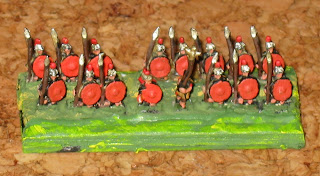 |
| 1/72, 1/76, OO or 20mm. Call it what you will, it was a common starting point for most people of my generation. |
Historical wargamers tend to be of a certain age and they began with what was available at the time. My first schoolboy armies were 1/72 Airfix figures and vehicles and some somewhat smaller Roco Minitanks though that didn't really bother me at the time. When I came back into wargaming in the later 70s I was mad for Ancients and gave away the 1/72 AFVs I had rescued from from parental disposal. This effectively broke my own connection with 1/72 but this seems somewhat untypical. (I should point out that when I use the term '1/72', I mean the ranges variously made and described as OO, 1/72, 1/76 or 20mm. Let's not be pedantic.)
When I started playing WRG Ancients, and then Renaissance, everyone at my wargames club was using 25mm figures, and I followed suit. As time went on, availability and fashion drove me towards 15mm. When I diversified into other periods - 6mm Napoleonic or 1/300 Cold War – it was again the peer pressure of fellow club members that determined periods, rules and scales.
 |
| 10mm armour: conveying "essential tank-like qualities" |
Thanks to the 'Wargame Deconstuctionism' of Wargame Developments, we know that using toy soldiers to represent 'units' is purely symbolic. Even when models are used at 1:1 scale, ground scales are still usually telescoped. Nevertheless, there does seem to be a general consensus in the wargaming world that, say, 28mm figures are good for 1:1 skirmish games and that 6mm or even 2mm is good for grand-tactical level games, with a range of gradations in between.
Players of Tim Gow's Megablitz have no qualms in using single 1/72 models to represent whole battalions. Now, if I hadn't parted company with my own 1/72 stuff, I'd be getting it out of the cupboard now. Nevertheless, the bumper-to-bumper 'map room' look is not my first preference, so for Megablitz or Megablitz-variant armies, I'm more inclined to 3mm than 1/72.
Whilst I have armies ranging from Marlburians in 6mm to Ardennes in 28mm, 10mm is probably my default option. It's the one I chose for my 1690 armies, for the ACW, for Square Bashing and for my WW2 Normandy armies. For pre-20thC armies 10mm seems to me to strike a good balance between the impression of massed ranks and the identification of unit types, while for 20thC armies, you can deploy a lot of hardware and it is 'chunky' enough to convey essential tank-like qualities. For Crossfire, however, which requires much fewer numbers and is essentially an infantry game, I preferred to go one higher and chose 15mm.
BASING
 |
| 6mm Late Romans for DBA: two ranks better |
For future armies, however, a combination of painting ennui and storage and transport limitations, is now impelling me towards 3mm where suitable models are available, and that may well prove to be my terminal scale of preference.
No comments:
Post a Comment